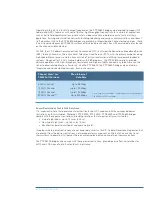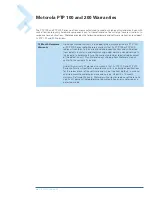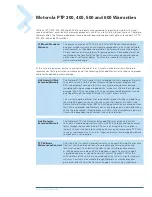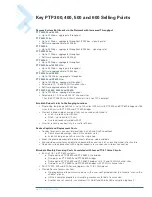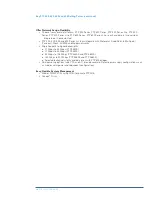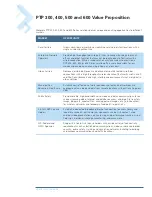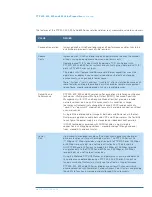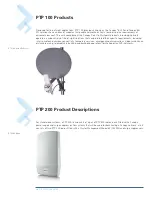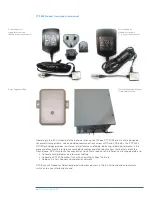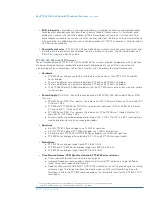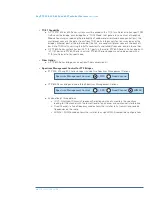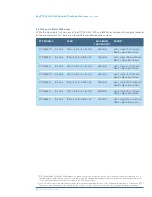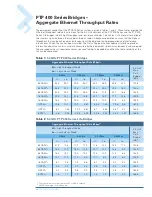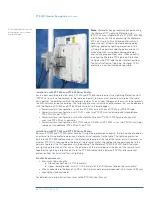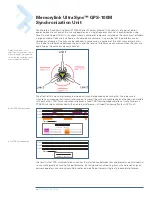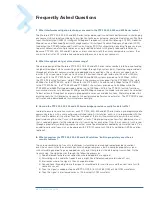
PTP SOLUTIONS GUIDE
3
•
Built-in Security
is provided via a complex proprietary-scrambling mechanism and matched-radios
technique that provides excellent over-the-air security for data transmissions. At installation, each
outdoor unit comes with the MAC address of the other outdoor unit to which it will connect. The
preset addresses enable the system’s security features and allow the two units to communicate only
with each other. An added layer of security can be applied with FIPS-197 compliant, 128-bit or 256-bit
AES Encryption (optional).
•
physical Form Factor
– PTP 300, 400, 500 and 600 Series systems share the same form factor and
are offered in Integrated or Connectorized* (external antennas) versions. The Powered Indoor Unit
(PIDU Plus) supports ±48VDC and AC.
pTp 300, 400, 500 and 600 Differences:
The differences between PTP 300, 400, 500 and 600 Series systems provide the operator with a selection
of choices based on features, bandwidth requirements and price points to cost effectively establish
a long range LoS or a challenging nLoS or NLoS wireless link. The primary feature differences are:
•
Hardware
>
PTP 400 Series bridges use different hardware and electronics than PTP 300, 500 and 600
Series bridges
>
There is no difference in hardware between PTP 400 and PTP 400 Lite bridges
>
There is no difference in hardware between PTP 600 and PTP 600 Lite bridges
>
The PTP 25600 and PTP 45600 models within the PTP 600 family of solutions are not available
in Lite versions
•
power Supply
(PIDU Plus) – key differences between the PTP 300, 400, 500 and 600 Series PIDU
Plus are:
>
PTP 400 Series PIDU Plus - powers the radio over CAT5 100 Base-T Ethernet; AC and ±48VDC;
100 Base-T PoE
>
PTP 300 and PTP 500 Series PIDU Plus – powers the radio over CAT 5e 100 Base-T Ethernet;
AC and ±48VDC; 100 Base-T PoE
>
PTP 600 Series PIDU Plus - powers the radio over CAT 5e 1000 Base-T Gigabit Ethernet; AC
and ±48VDC; 1000 Base-T PoE
>
Power supplies are outdoor-temperature rated at -40° F (-40°C) to 140° F (+60°C) and require a
weatherproof enclosure when mounted outdoors.
•
Spectrum
>
5.4 GHz PTP 400 Series bridges use 12 MHz of spectrum
>
4.9 GHz PTP 400 Series (PTP 49400) bridges use 10 MHz of spectrum
>
5.4 and 5.8 GHz PTP 300 AND PTP 500 Series bridges use 15 MHz of spectrum
>
PTP 600 Series bridges offer selectable 5, 10, 15 and 30** MHz channel widths
•
Modulation
>
PTP 400 Series bridges range from BPSK to 64 QAM
>
PTP 300 and PTP 500 Series bridges range from BPSK to 64 QAM
>
PTP 600 Series bridges range from BPSK to 256 QAM
•
Time Division Duplex (TDD) Synchronization in pTp 600 Series solutions
>
Times and synchronizes transmit and receive signals
>
Improved frequency reuse enables collocation of multiple PTP radios on a single rooftop or
tower with greatly reduced interference
>
Requires a Memorylink UltraSync™ GPS-100M synchronization unit to provide a precise timing-
reference signal that originates from the atomic clocks on GPS satellites orbiting the earth;
this signal is fed to the PTP 600 radio and used as the timing reference for the PTP 600’s TDD
functionality
Key pTp 300, 400, 500 and 600 Technical Features
continued
* Connectorized antennas are sold separately. See Appendix B for a list of compatible antennas.
** In the PTP 25600 system, the 30 MHz channel is not FCC compliant.

